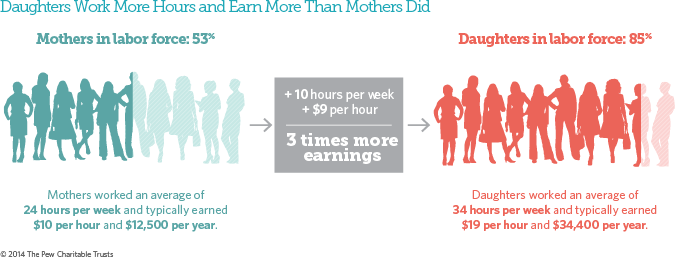Women's Work: The Economic Mobility of Women Across a Generation
Men have long been the dominant participants in the paid labor force, but a significant number of women have joined them during the past 40 years. In the early 1970s, 43 percent of all women were wage earners. Today, nearly 6 in 10 women are working for pay.
Much of this growth can be attributed to working mothers, who increased their numbers in the workforce by 50 percent over the past generation. Previous research by The Pew Charitable Trusts shows that, as more women entered the labor force, movement up the economic ladder increasingly became a family enterprise.
Measuring men's mobility over the past generation has been a relatively straightforward task. A majority of fathers and their sons entered and remained in the workforce, providing researchers with comparable data on income, wages, and earnings. But determining the mobility of women – and with it the importance of their contributions to family economic security – is more complicated.

For example, comparing daughters' earnings with those of their mothers could overestimate the daughters' economic gains, because many more daughters work in the labor force than their mothers did a generation ago. Comparing daughters' earnings with their fathers' could underestimate the daughters' gains because of gender differences, particularly in wages, work schedules, and employment sectors as well as other factors.
This report creates more accurate earnings comparisons between parent-child pairs by controlling for these demographic and labor market differences. First, hourly wages are compared across generations in order to understand changes in women's pay, independent from the dramatic increases in women's hours worked. Then daughters' earnings are adjusted to match the work hours of their mothers to explore what daughters' economic standing would be if women's labor force participation had remained constant over a generation. Similarly aged fathers and sons are also included as points of comparison.
Key findings include:
- Median hourly wages increased for both women and men compared with the previous generation. At every rung of the economic ladder, women's median wages rose by 50 percent or more, but daughters continue to earn lower hourly wages than fathers did on the same rung.
- Daughters working full time contribute more than half of family incomes, strengthening financial security. The extent of this contribution, however, varies based on family structure: Daughters who are in a couple (either married or cohabiting) supply 45 percent. Single daughters supply 81 percent, with the remainder of their income from nonwage sources.
- Daughters' higher hours worked are associated with increased rates of upward family earnings mobility, especially in the bottom and middle of the earnings distribution.
- Despite women's significant generational gains, men's wages remain more important to increasing couples' family income, a key factor for upward mobility.






